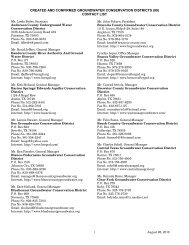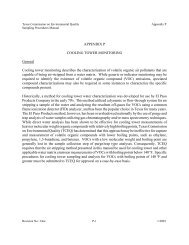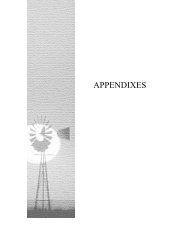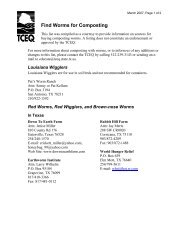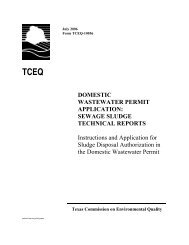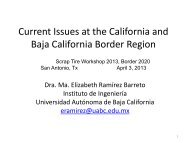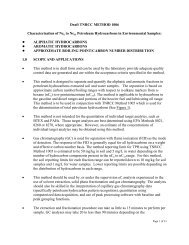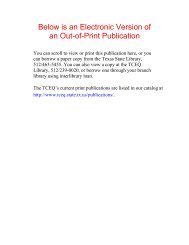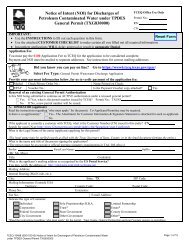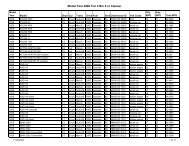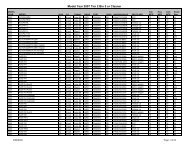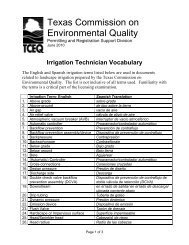The red wolf <strong>on</strong>ce inhabited the Grand Prairie (29d). It is intermediate insize between the gray wolf and the coyote. Photo: Greg Koch, USFWSSome comm<strong>on</strong> Great Plains animals, such as black-tailed jackrabbits (Lepuscalifornicus) and the scissortail flycatcher (Tyrannus forficatus), range farther eastthrough the Grand Prairie, creating an overlap in Great Plains and eastern forestspecies. The Grand Prairie was <strong>on</strong>ce also the home <str<strong>on</strong>g>of</str<strong>on</strong>g> bis<strong>on</strong> (Bis<strong>on</strong> bis<strong>on</strong>), red wolf(Canis rufus), and black bear (Ursus americanus). Red wolf numbers were decimatedal<strong>on</strong>g with gray wolves (Canis lupus m<strong>on</strong>strabilis) under predator c<strong>on</strong>trol programsin the late 19 th and early 20 th centuries; the last <str<strong>on</strong>g>of</str<strong>on</strong>g> the red wolves in the wild in <str<strong>on</strong>g>Texas</str<strong>on</strong>g>hybridized with coyotes (Schmidley 2002).Level IV Ecoregi<strong>on</strong>Area (sq. mi.) 3298PhysiographyElevati<strong>on</strong> /Local Relief (feet)Surficial Geology;Bedrock GeologySoil Order (Great Groups)Comm<strong>on</strong> Soil SeriesSoil Temperature /Soil Moisture RegimesMean Annual Precipitati<strong>on</strong> (in.) 33-37Mean Annual Frost Free Days 220-245Mean Temperature (F)(Jan. min/max; July min/max)Vegetati<strong>on</strong>Land Cover and Land Use29d. Grand PrairieRolling plains with some bedrock exposure. Meandering, incised streams.450-1170 /50-300Quaternary and Tertiary st<strong>on</strong>y calcareous clay soluti<strong>on</strong> residuum and silty claydecompositi<strong>on</strong> residuum;Lower Cretaceous limest<strong>on</strong>e, marl, and clayst<strong>on</strong>e.Mollisols (Calciustolls, Haplustolls), Inceptisols (Haplustepts), Entisols(Ustorthents), Alfisols (Paleustalfs, Haplustalfs), Vertisols (Haplusterts)C<strong>on</strong>vex uplands and slopes: Aledo, Bolar, Eckrant, Purves, Dugout, Maloterre.Level uplands: Dent<strong>on</strong>, Crockett. Erosi<strong>on</strong>al footslopes: Cranfill. Stream terraces:Wils<strong>on</strong>, Burles<strong>on</strong>.Thermic /Ustic, Udic Ustic31/55;72/96Upland tall to midgrass prairie. Minimally disturbed grasslands: big bluestem,yellow Indiangrass, sideoats grama, little bluestem, switchgrass, tall dropseed,<str<strong>on</strong>g>Texas</str<strong>on</strong>g> cupgrass. Grazed grasslands: silver bluestem, grama grasses, <str<strong>on</strong>g>Texas</str<strong>on</strong>g>wintergrass, purple threeawn, seep muhly, buffalograss, mesquite, introducedbermudagrass and Kleingrass. Escarpments: plateau live oak, juniper, sumac, <str<strong>on</strong>g>Texas</str<strong>on</strong>g>persimm<strong>on</strong>. Riparian woodland: elm, hackberry, bur oak, pecan.Pasture, grassland, shrubland, urban. Grazing, dairy farming, some cropland <str<strong>on</strong>g>of</str<strong>on</strong>g>corn, grain sorghum, and wheat.29e Limest<strong>on</strong>e Cut PlainThe Limest<strong>on</strong>e Cut Plain is similar to the Edwards Plateau (30) in its woodlandvegetati<strong>on</strong>, but the Edwards Limest<strong>on</strong>e substrate preferred by this vegetati<strong>on</strong> type ismore restricted in the Limest<strong>on</strong>e Cut Plain. Ecoregi<strong>on</strong> 29e has a more varied geologythan Ecoregi<strong>on</strong> 30, and it is more highly eroded. It has higher precipitati<strong>on</strong> amounts thanthe Edwards Plateau, and its grasslands have elements <str<strong>on</strong>g>of</str<strong>on</strong>g> the eastern tallgrass prairie.The Limest<strong>on</strong>e Cut Plain is bounded <strong>on</strong> the west by the sandst<strong>on</strong>es and clays that supportCross Timbers oak woodland, <strong>on</strong> the east by the remnant Balc<strong>on</strong>es Escarpment marking the boundary withthe Blackland Prairie (32), and <strong>on</strong> the north by the transiti<strong>on</strong> to the smoother topography <str<strong>on</strong>g>of</str<strong>on</strong>g> the Grand Prairie.The southern boundary is a transiti<strong>on</strong> to the Balc<strong>on</strong>es Cany<strong>on</strong>lands (30c), with its characteristic oak motte/Ashe juniper woodland, dissected cany<strong>on</strong> topography, and spring-fed streams.Mesas alternate with broad intervening valleys in the stairstep topography <str<strong>on</strong>g>of</str<strong>on</strong>g> the Limest<strong>on</strong>e Cut Plainecoregi<strong>on</strong>. Although Edwards Limest<strong>on</strong>e caps the highest buttes, the Limest<strong>on</strong>e Cut Plain is distinguished byother Lower Cretaceous limest<strong>on</strong>es, predominately the Glen Rose Formati<strong>on</strong> and Walnut Clay, that are older<str<strong>on</strong>g>Ecoregi<strong>on</strong>s</str<strong>on</strong>g> <str<strong>on</strong>g>of</str<strong>on</strong>g> <str<strong>on</strong>g>Texas</str<strong>on</strong>g> 41
than the limest<strong>on</strong>e <str<strong>on</strong>g>of</str<strong>on</strong>g> the Edwards Plateau (30). The Glen Rose Formati<strong>on</strong> has alternating layers <str<strong>on</strong>g>of</str<strong>on</strong>g> limest<strong>on</strong>e,chert, and marl that erode differentially and generally more easily than the Edwards Limest<strong>on</strong>e. The effects <str<strong>on</strong>g>of</str<strong>on</strong>g>increased precipitati<strong>on</strong> and run<str<strong>on</strong>g>of</str<strong>on</strong>g>f are also apparent in the increased erosi<strong>on</strong> and dissoluti<strong>on</strong> <str<strong>on</strong>g>of</str<strong>on</strong>g> the limest<strong>on</strong>elayer. The Limest<strong>on</strong>e Cut Plain has flatter topography, lower drainage density, and a more open woodlandcharacter than the Balc<strong>on</strong>es Cany<strong>on</strong>lands (30c).The soils over the limest<strong>on</strong>e substrate are shallow. The broad lowlands generally c<strong>on</strong>tain grasslandsgrowing <strong>on</strong> the Walnut Clay. The narrow mesa divides, capped by Edwards Limest<strong>on</strong>e, support oak savanna,and uncapped mesas may also support prairie. The woodland vegetati<strong>on</strong> <str<strong>on</strong>g>of</str<strong>on</strong>g> Ecoregi<strong>on</strong> 29e is similar tothat <str<strong>on</strong>g>of</str<strong>on</strong>g> the Balc<strong>on</strong>es Cany<strong>on</strong>lands, but less diverse; it includes plateau live oak (Q. fusiformis), cedar elm(Ulmus crassifolia), <str<strong>on</strong>g>Texas</str<strong>on</strong>g> ash (Fraxinus texensis), big tooth maple (Acer grandidentatum), and bur oak (Q.macrocarpa). Other endemic Edwards Plateau (30) floral species are prevalent. The dry rocky slopes havelittle soil, but they may have a sparse cover <str<strong>on</strong>g>of</str<strong>on</strong>g> white shin oak (Q. sinuata var. breviloba), sumac (Rhus spp.),and Ashe juniper (Juniperus asheii). Although the grasslands <str<strong>on</strong>g>of</str<strong>on</strong>g> the Limest<strong>on</strong>e Cut Plain are a mix <str<strong>on</strong>g>of</str<strong>on</strong>g> tall, mid,and short grasses, some c<strong>on</strong>sider it a westernmost extensi<strong>on</strong> <str<strong>on</strong>g>of</str<strong>on</strong>g> the tallgrass prairie, which distinguishes thisecoregi<strong>on</strong> from the Edwards Plateau Woodland (30a). Presettlement grasslands included species such as bigbluestem (Andropog<strong>on</strong> gerardii), little bluestem (Schizachyrium scoparium), yellow Indiangrass (Sorghastrumnutans), tall dropseed (Sporobolus asper var. asper), and sideoats grama (Bouteloua curtipendula). Thesetallgrass prairies <strong>on</strong>ce supported herds <str<strong>on</strong>g>of</str<strong>on</strong>g> bis<strong>on</strong>. With c<strong>on</strong>centrated grazing these grasses have been replacedby species such as silver bluestem (Bothriochloa laguroides ssp. torreyana), <str<strong>on</strong>g>Texas</str<strong>on</strong>g> wintergrass (Stipaleucotricha), and purple threeawn (Aristida purpurea). As in some other limest<strong>on</strong>e regi<strong>on</strong>s (e.g., <str<strong>on</strong>g>Ecoregi<strong>on</strong>s</str<strong>on</strong>g>30a, 30c, 29f), fire suppressi<strong>on</strong> and grazing have changed the nature <str<strong>on</strong>g>of</str<strong>on</strong>g> the oak savanna and grassland throughthe expansi<strong>on</strong> <str<strong>on</strong>g>of</str<strong>on</strong>g> shrubs such as Ashe juniper and mesquite. Where they are present, mature Ashe juniperstands have value as nesting habitat for the endangered golden-cheeked warbler (Dendroica chrysoparia) thatnests in low numbers in this ecoregi<strong>on</strong>.The Cross Timbers ecoregi<strong>on</strong> is a “crossroads” <str<strong>on</strong>g>of</str<strong>on</strong>g>landscapes and vegetati<strong>on</strong> types with its prairiesand woodlands. The pale yucca (Yucca pallida)in bloom here is endemic to a six-county area<str<strong>on</strong>g>of</str<strong>on</strong>g> central <str<strong>on</strong>g>Texas</str<strong>on</strong>g> where the southern part <str<strong>on</strong>g>of</str<strong>on</strong>g> theCross Timbers (29) meets <str<strong>on</strong>g>Ecoregi<strong>on</strong>s</str<strong>on</strong>g> 30 and 32.Photo: Clarence RechenthinThe Paluxy River is deeply incised into the soluble Lower Cretaceous limest<strong>on</strong>es<str<strong>on</strong>g>of</str<strong>on</strong>g> Ecoregi<strong>on</strong> 29e. Photo: John CrossleyThe Glen Rose Formati<strong>on</strong>, exposed at thesurface <str<strong>on</strong>g>of</str<strong>on</strong>g> the Limest<strong>on</strong>e Cut Plain (29e),c<strong>on</strong>tains dinosaur tracks <str<strong>on</strong>g>of</str<strong>on</strong>g> both carnivoroustheropods (pictured here) and herbivoroussauropods. Photo: Keith Minor42<str<strong>on</strong>g>Ecoregi<strong>on</strong>s</str<strong>on</strong>g> <str<strong>on</strong>g>of</str<strong>on</strong>g> <str<strong>on</strong>g>Texas</str<strong>on</strong>g>
- Page 1: Below is an Electronic Version <str
- Page 4 and 5: ECOREGIONS OF TEXAS</strong
- Page 6 and 7: TABLE OF CONTENTSABSTRACT..........
- Page 8 and 9: 2526272526272330293235332430323423
- Page 10 and 11: INTRODUCTIONSpatial frameworks are
- Page 12 and 13: Maps of environmen
- Page 14 and 15: vegetation or small areas o
- Page 16 and 17: the only chipmunk in Texas<
- Page 18 and 19: to the north. There is a high deman
- Page 20 and 21: taller, coarser tobosa grass (Pleur
- Page 22 and 23: the fractured rock. The Bof
- Page 24 and 25: hollows, moving upslope to create c
- Page 26 and 27: The headwater catfish (Ictalurus lu
- Page 28 and 29: streams. Two sand plains streams, C
- Page 30 and 31: Several caliche horizons (calcium c
- Page 32 and 33: winds (Spearing 199</strong
- Page 34 and 35: Geology is an important geographica
- Page 36 and 37: the villages of Pa
- Page 38 and 39: Area (sq. mi.) 5569PhysiographyFlat
- Page 40 and 41: Tableland topography of</st
- Page 42: y the Brazos and Colorado rivers ha
- Page 45 and 46: Level IV Ecoregion27i. Broken Red P
- Page 47 and 48: Post oaks (Quercus stellata) and bl
- Page 49: Level IV Ecoregion29c. Western Cros
- Page 53 and 54: underlying the sandstone. This has
- Page 55 and 56: Since settlement, many wildlife spe
- Page 57 and 58: (Pellaeae spp.), Nuttall’s stonec
- Page 59 and 60: Trinity-Edwards aquifer, discharges
- Page 61 and 62: Edwards Plateau to savanna-like con
- Page 63 and 64: species list, prefers fast moving w
- Page 65 and 66: Level IV Ecoregion31a. Northern Nue
- Page 67 and 68: 31c Texas-Tamaulip
- Page 69 and 70: 31d Rio Grande Floodplain and Terra
- Page 71 and 72: 62shrink when dry and swell when we
- Page 73 and 74: 32b Southern Blackland PrairieThe S
- Page 75 and 76: 33 EAST CENTRAL TE
- Page 77 and 78: and need some patchy distubances an
- Page 79 and 80: 33d Northern Prairie OutliersThe sm
- Page 81 and 82: Level IV Ecoregion33e. Bastrop Lost
- Page 83 and 84: 34a Northern Humid Gulf Coastal Pra
- Page 85 and 86: 34b Southern Subhumid Gulf Coastal
- Page 87 and 88: occasional discontinuous drainage r
- Page 89 and 90: oundary was the ability to match th
- Page 91 and 92: Level IV Ecoregion34f. Lower Rio Gr
- Page 93 and 94: live oak trees (Quercus virginiana)
- Page 95 and 96: Shoal grass (Halodule wrightii) mea
- Page 97 and 98: Upland oak-pine forest in Ecoregion
- Page 99 and 100: 35c Pleistocene Fluvial TerracesThe
- Page 101 and 102:
35f FlatwoodsMostly flat to gently
- Page 103 and 104:
pasture, although some woodland sti
- Page 105 and 106:
invariant definition of</st
- Page 107 and 108:
how many stream sites/watersheds ar
- Page 109 and 110:
commonly believed. Typically, about
- Page 111 and 112:
CONCLUSIONS AND RECOMMENDATIONSThis
- Page 113 and 114:
104Ecoregions <str
- Page 115 and 116:
Biggs, B.J.F., M.J. Duncan, I.G. Jo
- Page 117 and 118:
Diggs, G.M., Jr., and P.C. Schulze.
- Page 119 and 120:
Graves, J. 2002. Texas</str
- Page 121 and 122:
Hunt, C.B. 1967. Physiography <stro
- Page 123 and 124:
Maxwell, T.C. 1979. Avifauna <stron
- Page 125 and 126:
Richmond, G.M., D.L. Weide, and D.W
- Page 127 and 128:
U.S. Department of
- Page 129 and 130:
Woods, A.J., J.M. Omernik, D.R. But
- Page 131 and 132:
Herbaceous Plants(Forbs, Grasses, a
- Page 133 and 134:
Hickory, BlackHickory, WaterHollyHu



